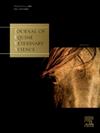Mutation rate and spectrum of germline de novo mutations in a closed population of Thoroughbred horses
IF 1.6
3区 农林科学
Q2 VETERINARY SCIENCES
引用次数: 0
Abstract
Background
Thoroughbreds have been maintained as a closed breed for over 300 years since the crossbreeding between Arabian stallions and English mares. Despite interest in germline de novo mutations across species, their frequency in horses, particularly in Thoroughbreds, remains largely unexplored.
Aims/objective
This study aimed to identify de novo mutations in Thoroughbreds and estimate their frequency within a genetically closed population.
Methods
We performed deep whole-genome sequencing (≥230× depth, 150 bp paired-end reads) and Sanger validation in a Thoroughbred trio (sire, dam, and foal). Reads were aligned to the EquCab3.0 reference genome, and variants in regions with sequencing depth ≥20 (covering 99.6 % of the genome) were analyzed for Mendelian inconsistencies.
Results
A total of 48 de novo mutations were identified, comprising 46 single nucleotide substitutions and 2 deletions, none of which were found in public variant databases. Of these, 18 were of paternal origin and 6 were of maternal origin (P < 0.05). The estimated mutation rate was 9.59 × 10⁻⁹, which is in a comparable range to that reported in humans. One mutation (chr7:g.2084761G>A) introduced a nonsense variant in the zinc finger protein 77 gene, which encodes a putative transcriptional regulator.
Conclusions
De novo mutations were identified in the Thoroughbred genome, and the mutation rate is consistent with estimates from other mammalian studies. A significant bias toward paternal origin was observed. Our findings suggest that germline de novo mutations are a source of novel genetic variation in Thoroughbreds, even within a genetically closed population.
纯种马封闭种群种系新生突变的突变率和谱
自阿拉伯种马和英国母马杂交以来,纯种马作为一个封闭品种已经维持了300多年。尽管人们对物种间的生殖系新生突变很感兴趣,但它们在马,尤其是纯种马中的频率,在很大程度上仍未被探索。目的/目的本研究旨在鉴定纯种马的新生突变,并估计其在遗传封闭群体中的频率。方法对三头纯种马(公马、公马和马驹)进行了深度全基因组测序(≥230×深度,150 bp对端reads)和Sanger验证。Reads与EquCab3.0参考基因组对齐,测序深度≥20(覆盖99.6%的基因组)区域的变异进行孟德尔不一致性分析。结果共鉴定出48个新生突变,包括46个单核苷酸替换和2个缺失,这些突变均未在公共变异数据库中发现。其中父系18例,母系6例(P < 0.05)。估计的突变率为9.59 × 10(毒血症),与人类报告的范围相当。一个突变(chr7:g.2084761G>;A)在锌指蛋白77基因中引入了一个无义变异,该基因编码一个假定的转录调节因子。结论在纯种马基因组中发现了新生突变,突变率与其他哺乳动物研究的估计一致。观察到对父系出身的显著偏见。我们的研究结果表明,即使在遗传封闭的种群中,种系新生突变也是纯种马新遗传变异的来源。
本文章由计算机程序翻译,如有差异,请以英文原文为准。
求助全文
约1分钟内获得全文
求助全文
来源期刊

Journal of Equine Veterinary Science
农林科学-兽医学
CiteScore
2.70
自引率
7.70%
发文量
249
审稿时长
77 days
期刊介绍:
Journal of Equine Veterinary Science (JEVS) is an international publication designed for the practicing equine veterinarian, equine researcher, and other equine health care specialist. Published monthly, each issue of JEVS includes original research, reviews, case reports, short communications, and clinical techniques from leaders in the equine veterinary field, covering such topics as laminitis, reproduction, infectious disease, parasitology, behavior, podology, internal medicine, surgery and nutrition.
 求助内容:
求助内容: 应助结果提醒方式:
应助结果提醒方式:


